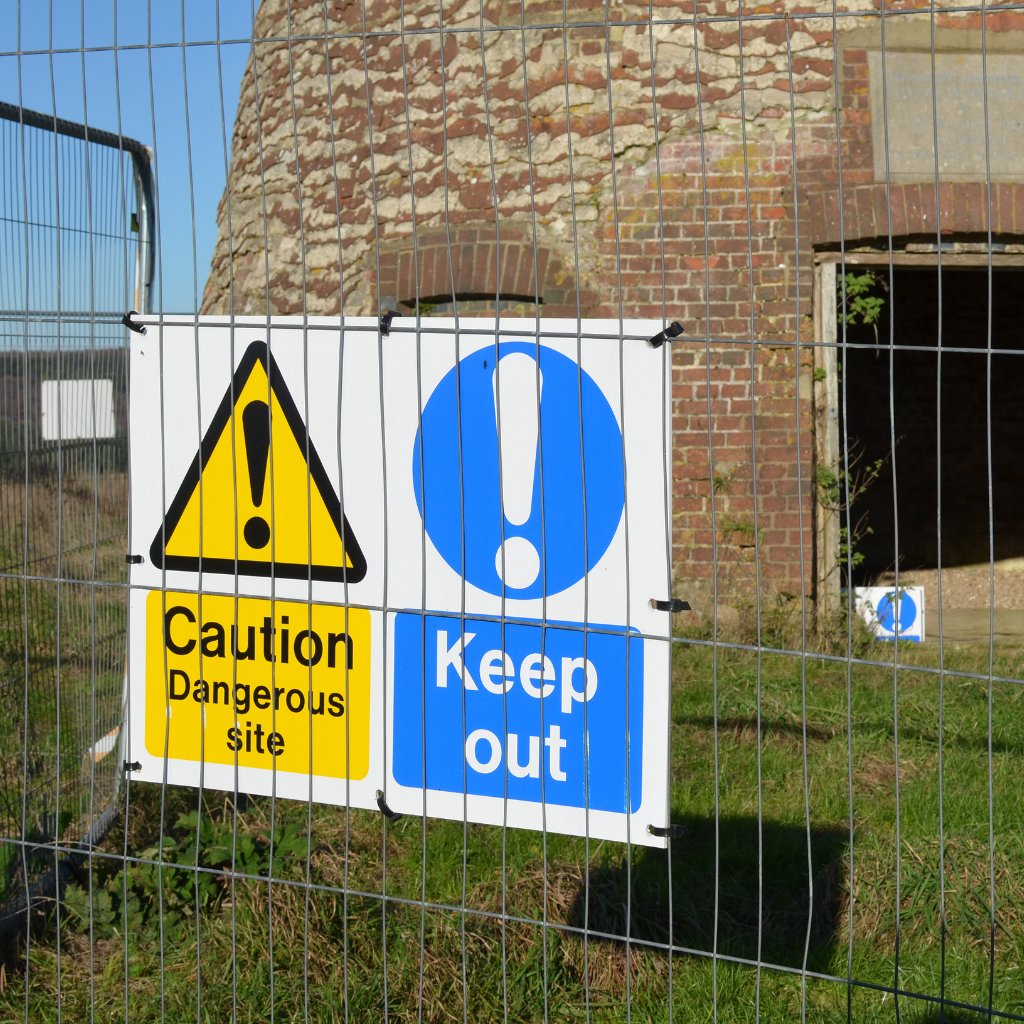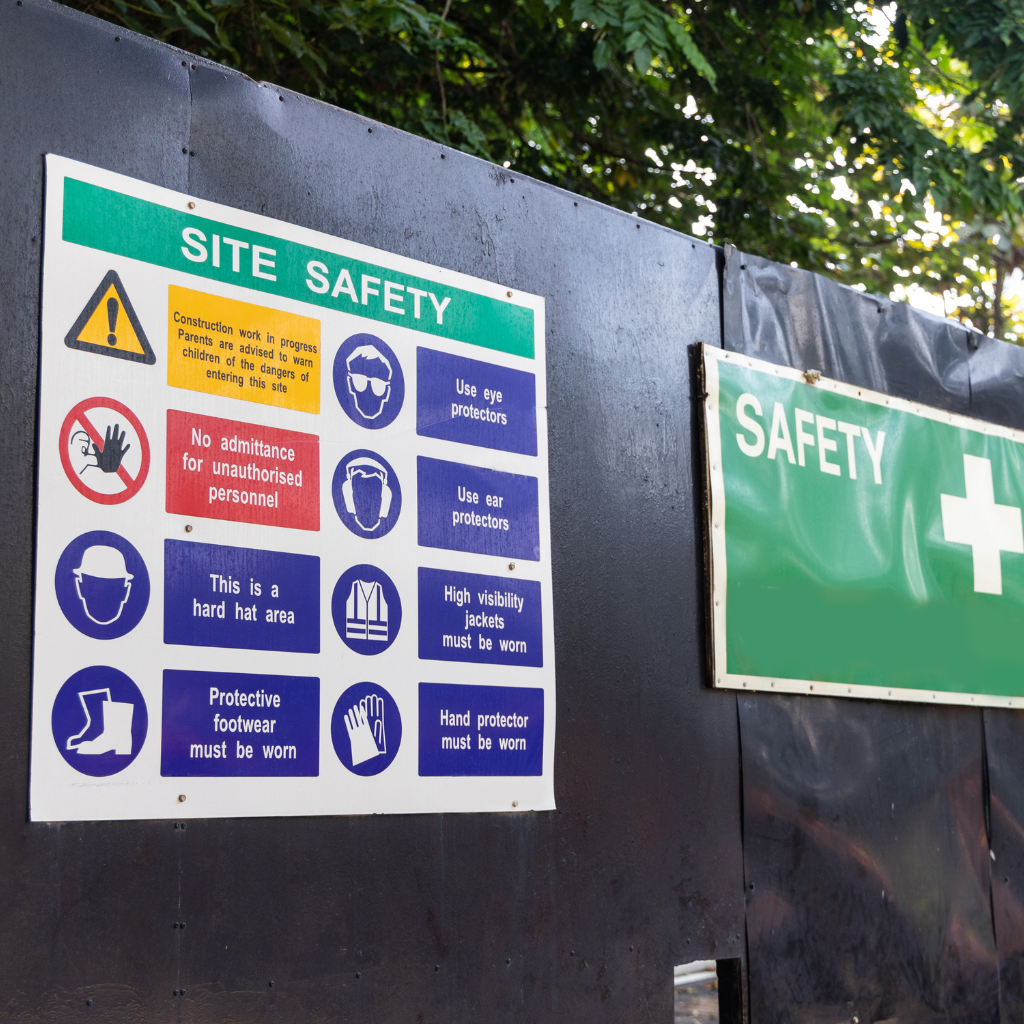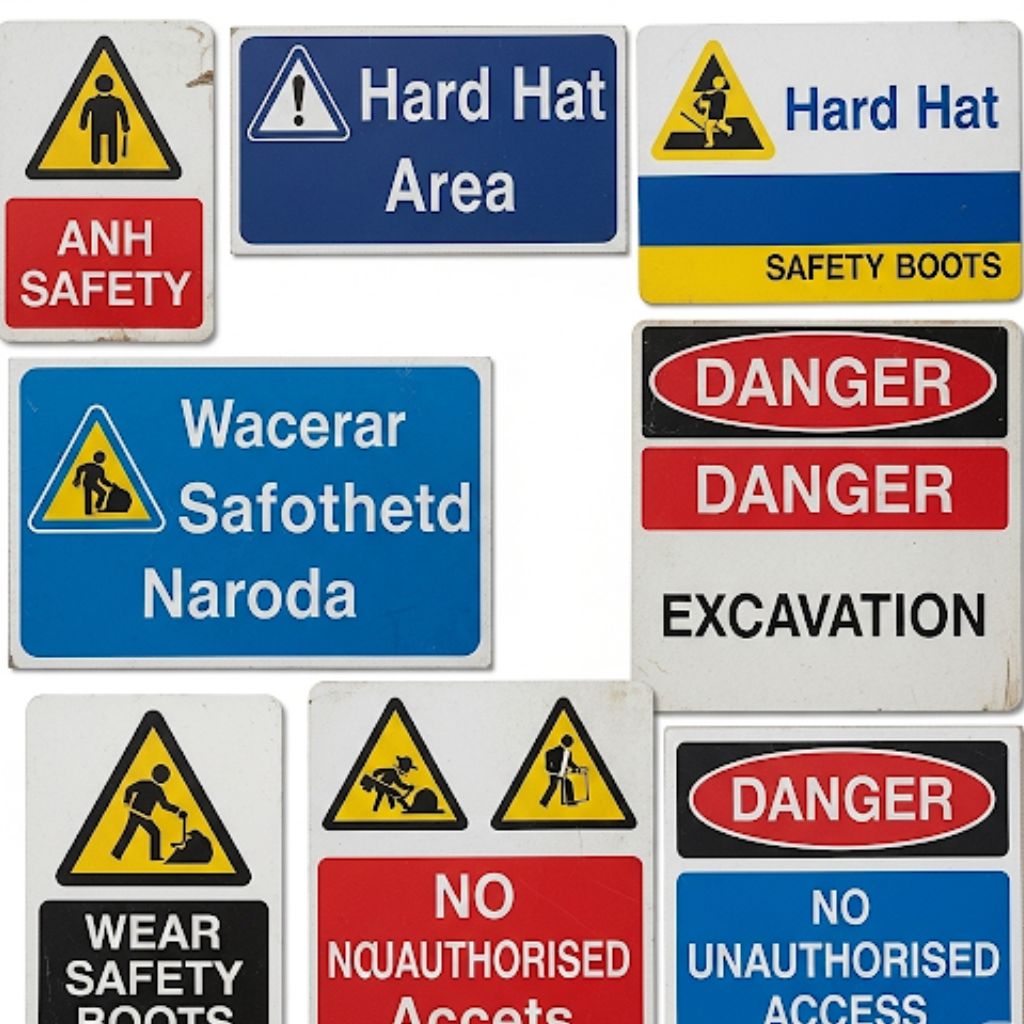Construction site safety signs play an essential role in worker protection by clearly communicating potential hazards, enforcing mandatory safety measures, and restricting access to high-risk areas. As a crucial part of outdoor signage solutions, these signs guarantee compliance with health and safety regulations, thereby minimising the risk of accidents and legal repercussions. Proper design and strategic placement enhance their effectiveness, while regular maintenance guarantees ongoing visibility. Learning more about these signs offers insights into optimising safety and regulatory adherence on construction sites.
Key Takeaways
- Construction safety signs communicate potential hazards, ensuring workers are aware and can take preventive measures.
- They enforce compliance with health and safety regulations, reducing legal risks and enhancing site safety.
- The placement of signs in high-risk areas helps prevent accidents by providing clear instructions and warnings.
- Safety signs guide workers to secure areas during emergencies, minimising injury risks.
- Durable and strategically placed signs maintain visibility and effectiveness, ensuring ongoing worker protection.
What Are the Different Types of Construction Site Safety Signs?
Construction site safety signs are categorised into distinct types, each serving a critical risk management function.
Mandatory signs provide instructions that must be followed to guarantee safety compliance, while warning signs alert workers and visitors to potential hazards that may not be immediately apparent.
Prohibition signs are essential in preventing specific actions that could lead to dangerous situations, thereby minimising the risk of accidents on site.
Understanding Mandatory Signs
Mandatory signs are critical in ensuring safety and compliance on construction sites. These construction safety signs are essential for directing workers to adhere to standards and utilise personal protective equipment. In many cases, these signs are displayed on temporary hoardings in construction projects, providing both visibility and accessibility while also helping delineate restricted or hazardous zones.
Effective site safety signs convey imperative instructions to maintain construction site safety and minimise risks.
- Safety Helmets Required: This mandatory sign is ubiquitous on safety sign boards for construction sites, ensuring workers wear helmets to protect against head injuries.
- Eye Protection Must Be Worn: Health and safety signs demand goggles to safeguard eyes from debris.
- Hearing Protection Mandatory: These signs are vital in noisy environments to prevent hearing damage.
- Keep Out: Restricts unauthorised access, ensuring only trained personnel enter high-risk areas.
Such signs are instrumental in maintaining a safe construction environment.
The Role of Warning Signs
Warning signs are crucial components of the spectrum of construction site safety measures, alerting workers and visitors to potential hazards and risks.
These construction safety sign boards are integral for site safety, providing immediate visual cues about the presence of hazards. Common safety signs used in construction sites include site warning signs like the “danger construction site” and “construction site keep out signs,” strategically placed at the site entrance and other critical points.
Such signs delineate areas of high risk, ensuring individuals remain vigilant. Properly deployed, these signs reduce the likelihood of accidents by forewarning site-specific dangers and reinforcing safe practices.
Practical risk assessment and implementation of these signs are essential for maintaining a secure construction environment.
Importance of Prohibition Signs
Even though prohibition signs are often overlooked, they play an essential role in maintaining safety on construction sites by clearly indicating actions that are not permitted.
Prohibition signs are vital components of safety signs for construction sites. They help enforce safety measures and enhance health and safety protocols. These signs, often on the site safety board, are critical for risk assessment and compliance with site rules.
Examples include:
- Danger Keep Out Signs: Warn unauthorised personnel to avoid restricted areas.
- No Entry Signs: Mark zones where entry is prohibited without proper clearance.
- No Smoking Signs: Prevent fire hazards by indicating areas where smoking is forbidden.
- No Mobile Phones Signs: Guarantee focus and prevent distractions in sensitive work areas.
Such construction site safety signs are indispensable for minimising hazards.
How Do Site Safety Signs Ensure Worker Safety?
Site safety signs are critical in mitigating risks and ensuring worker safety on construction sites by effectively communicating potential hazards.
Warning signs are a proactive measure to prevent accidents, while fire equipment signs are strategically placed to facilitate prompt access to emergency tools.
Additionally, safe condition signs guide workers toward secure areas, reducing the likelihood of injury or mishap.

Preventing Accidents with Warning Construction Site Signs
Implementing warning signs plays a crucial role in accident prevention on a construction site, which is dynamic and potentially hazardous.
Safety signs are strategically positioned to enhance worker protection and prevent accidents effectively. Key elements include warning construction site keep signs, which serve as clear indicators to unauthorised individuals to stay away and remind workers of ongoing dangers within restricted zones. Key elements include:
- Site Entrance Sign: Establishes the rules and requirements immediately upon entry, such as “safety helmets must be worn,” emphasising the necessity of personal protective equipment (PPE).
- Hazard Signs: Communicate specific dangers present, such as electrical risks or falling debris, ensuring workers are alert and cautious.
- Warning Construction Signs: Serve as a visual alert system to deter unsafe behaviours, reinforcing site safety protocols.
- Prohibition Signs: Indicate restricted actions, such as “no entry” zones, to control movement and minimise exposure to danger.
These measures collectively foster a safer construction environment.
The Function of Fire Equipment Signs on Site
When considering the vital role of fire equipment signs on a construction site, one must acknowledge their fundamental contribution to worker safety and emergency preparedness.
Fire equipment signs are strategically placed to guarantee immediate access to fire safety tools, minimising response time during emergencies. In the high-risk environment of a building site, clear and concise safety signs are paramount. These equipment signs provide unambiguous directions to fire extinguishers, hoses, and alarms.
Using standardised signage, construction sites maintain uniformity, enhance recognition, and reduce confusion. Warning signs are essential for risk assessment, as they mark fire hazards and emergency exits.
Through adequate signage, sites uphold regulatory compliance, safeguarding workers and assets. Properly implemented fire equipment signs are indispensable for thorough site safety.
Using Safe Condition Signs Effectively
Using safe condition signs is integral to guaranteeing worker safety on construction sites. These signs provide critical information on building construction safety signs and guide workers to safe areas during emergencies.
To maximise their impact, consider the following:
- Placement: Site signs should be strategically located to be visible and accessible to all individuals engaged in construction work.
- Clarity: Utilise clear and concise language or easily understood symbols, which is essential for different types of safety sign messages.
- Maintenance: Regularly inspect and maintain safety signs to guarantee they remain legible and practical throughout the construction site.
- Training: Educate workers on the importance and meaning of safe condition signs to enhance their response in emergencies and guarantee upheld construction site safety practices.
These strategies guarantee that signs show their intended purpose effectively.
Why Are Construction Site Keep-Out Signs Essential?
Construction site “Keep Out” signs are critical in enforcing site rules by clearly demarcating boundaries and communicating potential hazards to unauthorised individuals.
These signs are strategically placed to mitigate risks by preventing access to areas where construction activities pose significant safety threats.
Enforcing Site Rules with Keep Out Signs
Although construction sites are bustling hubs of activity, they inherently pose significant safety risks that necessitate strict access control measures.
Deploying construction health and safety signs, particularly keep-out signs, is essential in managing these risks. These signs delineate hazardous areas and ensure that only authorised personnel work on a construction site.
Keep out signs function as:
- Warning Construction Site: Alerting untrained individuals of potential dangers.
- Building Site Signs: Marking restricted zones to prevent unauthorised entry.
- Safety Signs Are Displayed: Ensuring visibility to all approaching the perimeter.
- Different Types of Signs: Facilitating compliance with regulations by providing clear instructions.
Understanding the Impact of Danger Keep Out Signs
Construction site risk mitigation relies heavily on strategic signage to manage safety hazards and control access. The “Danger Keep Out” sign is essential for worker protection, effectively communicating restricted areas. These signs are part of safety signs required by law, guaranteeing compliance and safety. Sign use in buildings marks areas needing extra caution, preventing unauthorised entry.
| Type of Sign | Purpose |
|---|---|
| Danger Keep Out | Prevent unauthorised access |
| First Aid | Indicate medical assistance |
| Safety Signs Mean | Define fundamental safety rules |
| UK Safety Signs | Compliance with regulations |
Understanding the impact of these signs on various types of construction sites is significant. They reduce risks, confirm that safety signs mean adherence to health protocols, and minimise accident rates. Utilising the UK safety signs ensures the consistent availability of compliant safety signage.
What Are the Legal Requirements for Construction Site Safety Signs?
Construction site safety signs must adhere to stringent legal requirements, ensuring compliance with established health and safety regulations.
These signs are mandated by law to communicate potential hazards, safety instructions, and emergency information to mitigate risks effectively.
Understanding the legal rules and compliance standards for construction health and safety signage is essential for preventing workplace accidents and ensuring a safe environment for workers and visitors.
Signs Required by Law in Construction
Ensuring compliance with legal requirements for construction site safety signs is essential to mitigate risks and maintain safety standards.
The use of boards and specific types of signs is dictated by the nature of the construction and the hazards present. Different types of construction demand varied signs required by law to alert workers and the public effectively.
Key requirements include:
- Warning Signs: Indicate potential hazards present on different types of sites, such as falling debris or electrical risks.
- Mandatory Signs: Specify actions that must be taken, like wearing hard hats in designated areas.
- Prohibition Signs: Indicate actions that are not permitted, such as smoking near flammable materials.
- Emergency Information Signs: Provide directions to emergency exits and first aid stations across all types of construction.
Compliance with Health and Safety Regulations
Although often overlooked, compliance with health and safety regulations is paramount in implementing construction site safety signs. Regulatory standards mandate the deployment of specific signage to mitigate risks and safeguard workers.
These signs must adhere to design specifications regarding size, colour, and symbology to guarantee clear communication of hazards. Failure to comply can result in significant legal repercussions, including fines and work stoppages, affecting project timelines and financial outcomes.
Adhering to regulations involves a detailed risk assessment to determine necessary signs—such as warning, mandatory, or prohibition signs—tailored to site-specific hazards. Regular audits and inspections are essential to maintain compliance and optimise site safety.
Ultimately, correctly implementing safety signs reduces accidents and enhances construction site safety culture.
Construction Health and Safety Signs: Legal Rules and Compliance
While often underestimated, the legal framework governing construction site safety signs is critical in risk management and site safety. Adhering to specific legal requirements guarantees that workers are adequately informed and protected from potential hazards.
Key compliance elements include:
- Visibility and Legibility: Safety signs must be visible and legible from a distance, guaranteeing that workers can easily understand them in various lighting conditions and weather scenarios.
- Standardisation: Signs must comply with standardised formats, such as BS EN ISO 7010, to maintain consistency and international recognition.
- Placement: Signs should be strategically placed where hazards are most likely to occur, such as entry points and high-risk areas.
- Maintenance: Regular inspections are required to guarantee signs remain intact, visible, and accurate to current site conditions.
How to Design Effective Construction Safety Signs?
Designing effective construction safety signs requires careful consideration of both the materials used and the signage’s strategic placement.
Selecting durable materials that can withstand harsh environmental conditions is critical to guaranteeing long-term visibility and compliance.
Equally important is the strategic placement of these signs to maximise visibility and guarantee that workers and visitors are consistently informed of potential hazards, thereby mitigating risks effectively.

Choosing the Right Signage Materials
Selecting the appropriate materials for construction site safety signs is essential for ensuring durability, visibility, and compliance with safety regulations. For insights into other types of popular signs, you might find this article on hanging wooden signs helpful. Similarly, if you’re considering a more classic or formal signage solution, you may be interested in selecting the perfect brass plaque for outdoor signage. The choice of signage materials directly impacts their effectiveness under various environmental conditions and potential hazards.
Key considerations include:
- Weather Resistance: Signs should withstand rain, wind, and UV radiation exposure to maintain legibility and integrity over time.
- Material Longevity: Selecting materials like aluminium or high-density polyethene can extend the lifespan of signs, reducing the frequency of replacements.
- Reflective Properties: Materials with reflective coatings or films are advisable to enhance visibility in low-light conditions.
- Compliance with Standards: Ensuring materials meet industry standards like HSE guarantees regulatory adherence and enhances worker safety.
Careful material selection mitigates risks and reinforces site safety protocols.
Impactful Sign Placement Strategies
An essential aspect of construction site safety is the strategic placement of signs, which significantly influences their effectiveness in conveying critical information. Proper placement guarantees visibility, reducing the risk of accidents.
Signs should be positioned at eye level and within key sightlines, especially at entry points and high-risk areas with heavy machinery or hazardous materials. Additionally, placement must consider environmental factors like lighting and weather conditions that could obscure visibility.
Using reflective materials increases sign visibility in low light. Regularly updating site maps to reflect current conditions helps maintain the relevance of sign placement.
Conducting risk assessments allows for the identification of potential hazards and guides the best positioning of signs to mitigate risks effectively.
Conclusion
In summary, site safety signs are essential for risk management and worker protection. These signs help prevent accidents and guarantee compliance with legal standards by clearly communicating hazards, restrictions, and safety instructions. The effectiveness of these signs relies on thoughtful design, visibility, and adherence to regulatory requirements. As a result, they play a vital role in fostering a safety culture, minimising risks, and safeguarding both workers and the public from potential construction site dangers.


